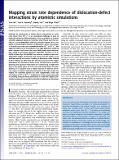Mapping strain rate dependence of dislocation-defect interactions by atomistic simulations
Author(s)
Fan, Yue; Osetsky, Yuri N.; Yip, Sidney; Yildiz, Bilge
DownloadYue Fan-2013-Mapping Strain-rate.pdf (1022.Kb)
PUBLISHER_POLICY
Publisher Policy
Article is made available in accordance with the publisher's policy and may be subject to US copyright law. Please refer to the publisher's site for terms of use.
Terms of use
Metadata
Show full item recordAbstract
Probing the mechanisms of defect–defect interactions at strain rates lower than 10[superscript 6] s[superscript −1] is an unresolved challenge to date to molecular dynamics (MD) techniques. Here we propose an original atomistic approach based on transition state theory and the concept of a strain-dependent effective activation barrier that is capable of simulating the kinetics of dislocation–defect interactions at virtually any strain rate, exemplified within 10[superscript −7] to 10[superscript 7] s[superscript −1]. We apply this approach to the problem of an edge dislocation colliding with a cluster of self-interstitial atoms (SIAs) under shear deformation. Using an activation–relaxation algorithm [Kushima A, et al. (2009) J Chem Phys 130:224504], we uncover a unique strain-rate–dependent trigger mechanism that allows the SIA cluster to be absorbed during the process, leading to dislocation climb. Guided by this finding, we determine the activation barrier of the trigger mechanism as a function of shear strain, and use that in a coarse-graining rate equation formulation for constructing a mechanism map in the phase space of strain rate and temperature. Our predictions of a crossover from a defect recovery at the low strain-rate regime to defect absorption behavior in the high strain-rate regime are validated against our own independent, direct MD simulations at 10[superscript 5] to 10[superscript 7] s[superscript −1]. Implications of the present approach for probing molecular-level mechanisms in strain-rate regimes previously considered inaccessible to atomistic simulations are discussed.
Date issued
2013-10Department
Massachusetts Institute of Technology. Department of Materials Science and Engineering; Massachusetts Institute of Technology. Department of Nuclear Science and EngineeringJournal
Proceedings of the National Academy of Sciences
Publisher
National Academy of Sciences (U.S.)
Citation
Fan, Y., Y. N. Osetskiy, S. Yip, and B. Yildiz. “Mapping Strain Rate Dependence of Dislocation-Defect Interactions by Atomistic Simulations.” Proceedings of the National Academy of Sciences 110, no. 44 (October 10, 2013): 17756–17761.
Version: Final published version
ISSN
0027-8424
1091-6490